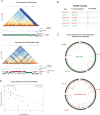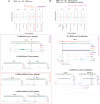Hidden origami in Trypanosoma cruzi nuclei highlights its non-random 3D genomic organization
- PMID: 40243368
- PMCID: PMC12077095
- DOI: 10.1128/mbio.03861-24
Hidden origami in Trypanosoma cruzi nuclei highlights its non-random 3D genomic organization
Abstract
The protozoan Trypanosoma cruzi is the causative agent of Chagas disease and is known for its polycistronic transcription, with about 50% of its genome consisting of repetitive sequences, including coding (primarily multigenic families) and non-coding regions (such as ribosomal DNA, spliced leader [SL], and retroelements, etc). Here, we evaluated the genomic features associated with higher-order chromatin organization in T. cruzi (Brazil A4 strain) by extensive computational processing of high-throughput chromosome conformation capture (Hi-C). Through the mHi-C pipeline, designed to handle multimapping reads, we demonstrated that applying canonical Hi-C processing, which overlooks repetitive DNA sequences, results in a loss of DNA-DNA contacts, misidentifying them as chromatin-folding (CF) boundaries. Our analysis revealed that loci encoding multigenic families of virulence factors are enriched in chromatin loops and form shorter and tighter CF domains than the loci encoding core genes. We uncovered a non-random three-dimensional (3D) genomic organization in which nonprotein-coding RNA loci (transfer RNAs [tRNAs], small nuclear RNAs, and small nucleolar RNAs) and transcription termination sites are preferentially located at the boundaries of the CF domains. Our data indicate 3D clustering of tRNA loci, likely optimizing transcription by RNA polymerase III, and a complex interaction between spliced leader RNA and 18S rRNA loci, suggesting a link between RNA polymerase I and II machineries. Finally, we highlighted a group of genes encoding virulence factors that interact with SL-RNA loci, suggesting a potential regulatory role. Our findings provide insights into 3D genome organization in T. cruzi, contributing to the understanding of supranucleosomal-level chromatin organization and suggesting possible links between 3D architecture and gene expression.IMPORTANCEDespite the knowledge about the linear genome sequence and the identification of numerous virulence factors in the protozoan parasite Trypanosoma cruzi, there has been a limited understanding of how these genomic features are spatially organized within the nucleus and how this organization impacts gene regulation and pathogenicity. By providing a detailed analysis of the three-dimensional (3D) chromatin architecture in T. cruzi, our study contributed to narrowing this gap. We deciphered part of the origami structure hidden in the T. cruzi nucleus, showing the unidimensional genomic features are non-randomly 3D organized in the nuclear organelle. We uncovered the role of nonprotein-coding RNA loci (e.g., transfer RNAs, spliced leader RNA, and 18S RNA) in shaping genomic architecture, offering insights into an additional epigenetic layer that may influence gene expression.
Keywords: CF unities; Hi-C; TAD boundaries; Trypanosoma cruzi; epigenetic; nonprotein-coding RNA loci; nuclear architecture.
Conflict of interest statement
The authors declare no conflict of interest.
Figures








References
MeSH terms
Substances
Grants and funding
LinkOut - more resources
Full Text Sources
Miscellaneous
